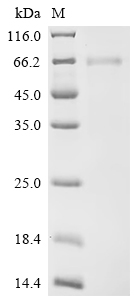DcR3 (human):Fc (human) (rec.)
CHI-HF-210DCR3
Protein IDO95407
Product group Proteins / Signaling Molecules
Overview
- SupplierChimerigen Laboratories
- Product NameDcR3 (human):Fc (human) (rec.)
- Delivery Days Customer10
- CertificationResearch Use Only
- Estimated Purity>98%
- Protein IDO95407
- Protein NameTumor necrosis factor receptor superfamily member 6B
- Scientific DescriptionDecoy receptor 3 (DcR3; TNFRSF6B; M68) is a member of the TNF receptor superfamily. DcR3 shares sequence identity with OPG (31%), TNF-RII (29%) and Fas (17%) and is expressed in a variety of different tissues and at high levels in many malignant tumors. Ligands of DcR3 include Fas ligand, homologous to lymphotoxin showing inducible expression and competing with HSV glycoprotein D for herpes virus entry mediator (a receptor expressed by T lymphocytes), TNF-like molecule 1A and heparan sulfate proteoglycans. DcR3 modulates the function of T cells, dendritic cells and macrophages. DcR3/Fc fusion proteins can bind to human and mouse B cells and suppress the activation of B cells. - Protein. The extracellular domain of human DcR3 (aa 24-300) is fused to the N-terminus of the Fc region of human IgG1. Source: CHO cells. Endotoxin content: 98% (SDS-PAGE). Decoy receptor 3 (DcR3; TNFRSF6B; M68) is a member of the TNF receptor superfamily. DcR3 shares sequence identity with OPG (31%), TNF-RII (29%) and Fas (17%) and is expressed in a variety of different tissues and at high levels in many malignant tumors. Ligands of DcR3 include Fas ligand, homologous to lymphotoxin showing inducible expression and competing with HSV glycoprotein D for herpes virus entry mediator (a receptor expressed by T lymphocytes), TNF-like molecule 1A and heparan sulfate proteoglycans. DcR3 modulates the function of T cells, dendritic cells and macrophages. DcR3/Fc fusion proteins can bind to human and mouse B cells and suppress the activation of B cells.
- Storage Instruction-20°C,2°C to 8°C
- UNSPSC12352202



